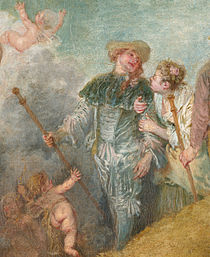The Embarkation for Cythera
 |
|
|
|
The Embarkation for Cythera ("L'Embarquement pour Cythère") is a painting by the French painter Jean-Antoine Watteau. It is also known as Voyage to Cythera and Pilgrimage to the Isle of Cythera. Watteau submitted this work to the Royal Academy of Painting and Sculpture as his reception piece in 1717. The painting is now in the Louvre in Paris. A second version of the work, sometimes called Pilgrimage to Cythera to distinguish it, was painted by Watteau about 1718 or 1719 and is in the Charlottenburg Palace, Berlin.
The painting portrays a "fête galante"; an amorous celebration or party enjoyed by the aristocracy of France during the Régence after the death of Louis XIV, which is generally seen as a period of dissipation and pleasure, and peace, after the sombre last years of the previous reign.
The work celebrates love, with many cupids flying around the couples and pushing them closer together, as well as the statue of Venus (the goddess of sexual love). There are three pairs of lovers in the foreground. While the couple on the right by the statue are still engaged in their passionate tryst, another couple rises to follow a third pair down the hill, although the woman of the third pair glances back fondly at the goddess’s sacred grove. At the foot of the hill, several more happy couples are preparing to board the golden boat at the left. With its light and wispy brushstrokes, the hazy landscape in the background does not give to any clues about the season, or whether it is dawn or dusk.
It has often been noted that, despite the title, the people on the island seem to be leaving rather than arriving, especially since they have already paired up. Many art historians have come up with a variety of interpretations of the allegory of the voyage to the island of love. Watteau himself purposely did not give an answer.
In the ancient world, Cythera, one of the Greek islands, was thought to be the birthplace of Venus, goddess of love. Thus, the island became sacred to the goddess and love. However, the subject of Cythera may have been inspired by certain 17th century operas or an illustration of a minor play. In Florent Carton Dancourt's Les Trois Cousines, a girl dressed as a pilgrim steps out from the chorus line and invites the audience to join her on a voyage to the island, where everyone will meet their ideal partner.
...
Wikipedia
